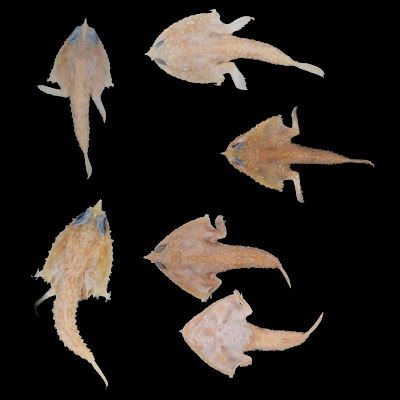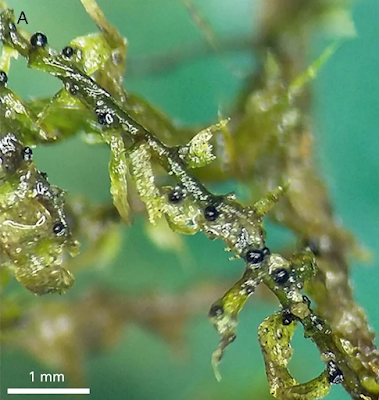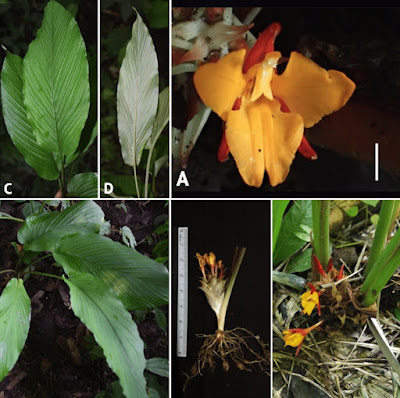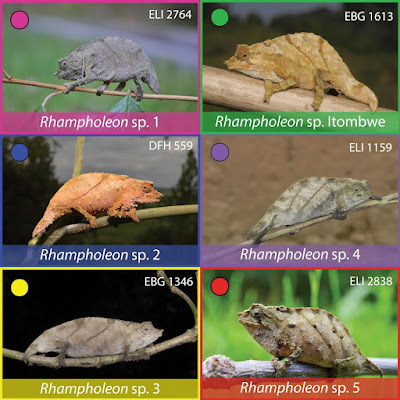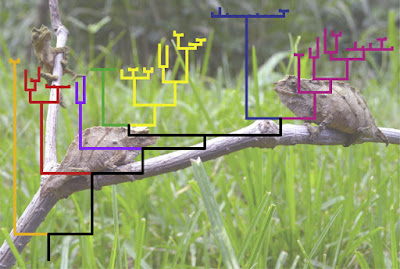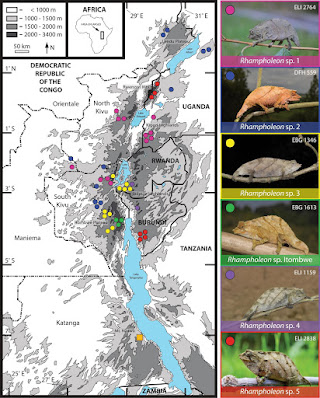[Most Recent Entries] [Calendar View]
Wednesday, February 10th, 2021
| Time | Event | ||||
| 3:56a | [Ichthyology • 2021] Review of the Batfish Genus Malthopsis (Lophiiformes: Ogcocephalidae) from Australia , with Descriptions of Five New Species
Abstract A taxonomic review of the batfish genus Malthopsis in the Australian waters is provided. Eleven valid species are recognized in this study: Malthopsis gigas Ho and Shao, 2010, Malthopsis parva Ho, Roberts and Shao, 2013, Malthopsis asperata Ho, Roberts and Shao, 2013, Malthopsis lutea Alcock, 1891, Malthopsis mitrigera Gilbert and Cramer, 1897, Malthopsis provocator Whitley, 1961, and an additional five species new to science. Four of these new species, Malthopsis apis sp. nov., Malthopsis bulla sp. nov., Malthopsis oculata sp. nov., and Malthopsis tetrabulla sp. nov. belong to a species group lacking spinules on the interspaces between bucklers of the ventral surface, whereas Malthopsis mcgroutheri sp. nov. belongs to another species group characterized by having spinules on the interspaces between bucklers of the ventral surface. Four other taxa were identified during this study that may be undescribed but require further investigation. The Australian endemic species M. provocator, formerly considered to be a synonym of Malthopsis kobayashii Tanaka, 1916, is resurrected herein and two widespread species, M. asperata and M. lutea, are newly recorded from Australia. A key to all Australian species is provided. Hsuan-Ching Ho and Peter Last. 2021. Review of the Batfish Genus Malthopsis from Australia (Lophiiformes: Ogcocephalidae), with Descriptions of Five New Species. Bulletin of Marine Science. 97(1); 165-218. DOI: 10.5343/bms.2020.0037 | ||||
| 7:43a | [Fungi • 2020] Bryostroma popei • A New Bryophilous Ascomycete (Ascomycota: Dothideomycetes) from the British Isles, with A Worldwide Key to the Genus Bryostroma
Summary The bryophilous Bryostroma popei is a novel ascomycete that infects the pleurocarpous moss Leptodictyum riparium. The morphology of the new species is described, illustrated and compared to other species in the genus. A key to the nine species of Bryostroma is provided. Bryostroma popei Greiff & P.F.Cannon, sp. nov. (Dothideomycetes, incertae sedis). Type: UK, Isle of Wight, Havenstreet, Briddlesford Copse, on decaying stems of Leptodictyon riparium, UK grid reference SZ556900, 26 Sept. 2019, G. R. L. Greiff. Holotype (K(M) 255204). [Index Fungorum IF557422]. HABITAT. Riparian ancient woodland; alt. approx. 15 m. The host plant Leptodictyum riparium (Hedw.) Warnst. (Amblystegiaceae, Hypnales, Bryidae, Bryophyta) was growing in a seasonal stream. ETYMOLOGY. popei, in honour of the Isle of Wight botanist, mycologist and excellent all-round naturalist Dr Colin R. Pope. George R. L. Greiff and Paul F. Cannon. 2020. Bryostroma popei — A New Bryophilous Ascomycete from the British Isles, with A Worldwide Key to the Genus Bryostroma. Kew Bulletin. 75: 60. DOI: 10.1007/s12225-020-09917-0 | ||||
| 9:20a | [Botany • 2019] Curcuma kayahensis (Zingiberaceae) • A New Species of Curcuma (Subgenus Ecomatae) from southeastern Myanmar [Taxonomic Studies on Zingiberaceae of Myanmar I]
Abstract In the course of taxonomic studies on Zingiberaceae in Myanmar, a new species of Curcuma assignable to subgenus Ecomatae was discovered. It is described and illustrated as Curcuma kayahensis, new to science from Kayah State, southeastern Myanmar. It is morphologically most similar to C. rhomba in having the orange-red and lateral staminodes with a rhombic shape, but differs in having rhizomes yellow inside, densely pubescent lower surface of lamina, inflorescence position central, bracts light green with red veins, flowers with a longer gently curved anther. Keywords: Curcuma kayahensis, Curcuma rhomba, Kayah State, new taxon
Curcuma kayahensis Nob. Tanaka & M.M. Aung sp. nov. Diagnosis:—Similar to Curcuma rhomba in orange-red lateral staminodes and labellum of a rhombic shape, however, it differs in having rhizomes yellow inside, lower surface of lamina densely covered with silver scales, the inflorescence position central, light green bracts with red veins, and flowers with longer gently curved anther. Etymology:—The specific epithet refers to the name of the state in Southeastern Myanmar where this species were discovered. Kayah State had been closed for a long time due to its local political situation, and opened only recently to outsiders including foreign nationals. Distribution:— So far known only from the type collection in Kayah State, Myanmar. It might be endemic to Myanmar. Nobuyuki Tanaka and Mu Mu Aung. 2019. Taxonomic Studies on Zingiberaceae of Myanmar I: A New Species of Curcuma (Subgenus Ecomatae) from Myanmar. Phytotaxa. 387(2); 241-248. DOI: 10.11646/phytotaxa.387.3.4 | ||||
| 1:20p | [Herpetology • 2018] Cryptic Diversity in Rhampholeon boulengeri (Sauria: Chamaeleonidae), A Pygmy Chameleon from the Albertine Rift Biodiversity Hotspot
Highlights: • Species diversity of pygmy chameleons in the Albertine Rift is underestimated. • Rhampholeon boulengeri is a complex of at least 6 species. • Diversification via allopatry underlies genetic patterns in genus-level phylogeny. • The R. boulengeri complex exhibits signatures of parapatric speciation. • We discuss the importance of investigating cryptic diversity in the montane Afrotropics. Abstract Several biogeographic barriers in the Central African highlands have reduced gene flow among populations of many terrestrial species in predictable ways. Yet, a comprehensive understanding of mechanisms underlying species divergence in the Afrotropics can be obscured by unrecognized levels of cryptic diversity, particularly in widespread species. We implemented a multilocus phylogeographic approach to examine diversity within the widely distributed Central African pygmy chameleon, Rhampholeon boulengeri. Gene-tree analyses coupled with a comparative coalescent-based species delimitation framework revealed R. boulengeri as a complex of at least six genetically distinct species. The spatiotemporal speciation patterns for these cryptic species conform to general biogeographic hypotheses supporting vicariance as the main factor behind patterns of divergence in the Albertine Rift, a biodiversity hotspot in Central Africa. However, we found that parapatric species and sister species inhabited adjacent habitats, but were found in largely non-overlapping elevational ranges in the Albertine Rift, suggesting that differentiation in elevation was also an important mode of divergence. The phylogeographic patterns recovered for the genus-level phylogeny provide additional evidence for speciation by isolation in forest refugia, and dating estimates indicated that the Miocene was a significant period for this diversification. Our results highlight the importance of investigating cryptic diversity in widespread species to improve understanding of diversification patterns in environmentally diverse regions such as the montane Afrotropics. Keywords: Biodiversity, Biogeography, Burundi, Diversification, Democratic Republic of the Congo, Kenya, Molecular systematics, Phylogeography, Rwanda, Uganda Daniel F. Hughes, Krystal A. Tolley, Mathias Behangana, Wilber Lukwago, Michele Menegon, J. Maximilian Dehling, Jan Stipala, Colin R. Tilbury, Arshad M. Khan and Chifundera Kusamba. 2018. Cryptic Diversity in Rhampholeon boulengeri (Sauria: Chamaeleonidae), A Pygmy Chameleon from the Albertine Rift Biodiversity Hotspot. Molecular Phylogenetics and Evolution. 122; 125-141. DOI: 10.1016/j.ympev.2017.11.015 |
| << Previous Day |
2021/02/10 [Calendar] |
Next Day >> |
